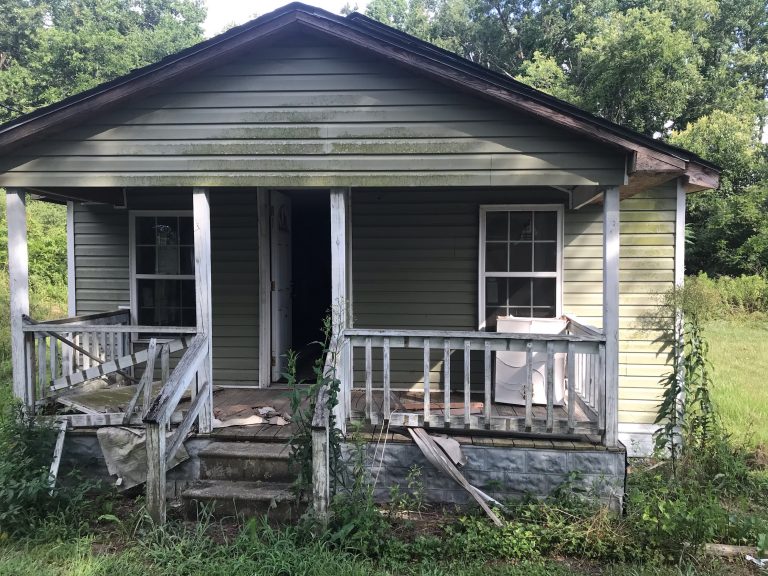Murky homeownership status derails flood relief in South Carolina

A home in Marion County, South Carolina, sustained flood damage, as seen in summer 2019. (Jasmine Simington)
This is part of a series of stories from the field for the “Understanding Communities of Deep Disadvantage” project.
By Jasmine Simington
MARION COUNTY, S.C. — Jerry Testle is tucked into the arm of his living room couch watching television when a local community leader escorts us into his home. He can barely adjust his body to greet us, and he smiles only with his lips when we introduce ourselves.
Testle is living in the housing structure where he has resided for most of his 70 years of life, despite the physical destruction his home suffered during back-to-back flooding in his small, rural town of Sellers.
Since 2017, he has lived in a single room of his house — the living room — and slept on one side of the couch at night, while propping himself up on the other side during the daytime in the position we found him when we first arrived at his house. Mold is climbing up the walls of the remainder of the house, and his sustained presence in the home has coincided with recently getting a pacemaker.
Disaster relief reserved for homeowners
When repetitive flooding devastated Testle’s town in 2016 and 2018, federal and local agencies made disaster relief funds available to the county — with stipulations, of course. Most importantly, individuals making claims to the Federal Emergency Management Agency and Long Term Recovery agencies for home repair or mobile unit replacements had to show proof of homeownership.
Documentation of housing status might seem reasonable enough, but this proved an insurmountable challenge for Testle. His late father owned the house, and from the perspective of Testle and a local advocate, the property now rightly belonged to Testle since he was the last living sibling and had been paying property taxes on the home since his father passed. He’s what we might call a “family heir,” or the person responsible for property passed down through family, but not through a formal will.
“They call their houses ‘family houses,'” said a Marion County community leader. “So you’ll look and you’ll see all these houses, when you look at the home ownership… the estate… [It’ll] have all these names…associated with home ownership. And that is not right. So the house is just inherited by all the surviving folk. And there’s so many houses like that, which limits how we can help them.”
Not a renter, not a homeowner
Unfortunately, as local advocates found out during the process of trying to help him get disaster relief aid, state authorities will not consider Testle the legal homeowner without state-recognized documentation of homeownership.
Therefore, he could not access aid to address the mold in his home and other damage that emerged after the flooding. Until Testle can locate his father’s death certificate and file the necessary paperwork to confirm he has been paying property taxes for a long enough stint, he is ineligible for disaster relief. It has been three years now since the first flood.
An informal safety net has emerged for Testle, and others in his situation, where neighbors and local organizations have stood in the gap of policy failures.
Neighbors regularly stop by to check on those still vulnerable after the storm. They’ve become informal disaster relief case managers, helping with paperwork and learning about the different programs available in order to spread the word. Testle is surrounded by capable community advocates, but he’s up against a system that doesn’t see him as a legitimate homeowner.
At the same time, by paying property taxes and taking responsibility for home repairs, he doesn’t fit the definition of renter, either.
Is he a homeowner? A renter? Something in between?
The spectrum of homeownership
Homeownership is traditionally thought of as binary: either you own your home or you rent from a landlord.
Yet, the case of Marion County illustrates the realities of homeownership status may be more complex. There is a spectrum of homeownership. There are households that cannot “prove” homeownership through traditional forms of documentation, but they also do not pay rent to a landlord with greater authority and legal responsibility over the physical structure.
Likewise, some individuals may be responsible for property taxes and home repairs, in the same way homeowners would be, even if their name is not the only one on the deed.
Multiple residents don’t fit into the categories of renter or homeowners, and their stories force us to reconsider the various ways households actually occupy housing units and seek to make legitimate claims of ownership over their residential spaces.
This spectrum of homeownership is not confined to Marion County. Although we learned about the specific case of how ownership status impacts access to disaster relief funds, other cities and towns reveal how housing status prevents access to a variety of forms of housing aid.
The stories Marion County residents recounted to us about barriers in accessing disaster relief funds echo narratives expressed by Black farmers being expelled from family-owned land, survivors of Hurricanes Maria, Harvey, and Katrina and Detroit residents trying to keep their homes in the face of the foreclosure crisis.
Potential solutions
Testle’s story was the norm in Marion County, but local community members also shared some stories of hope. In some instances, residents who came to disaster relief offices in the quasi-ownership status of “family heir” were able to obtain a “quitclaim deed” and successfully obtain disaster recovery assistance.
As explained by a Washington D.C.-based housing lawyer, quitclaim deeds differ from warranty deeds, the more traditional mechanism used to designate homeownership. Warranty deeds confer property ownership with assurance that the buyer owns the house “outright,” and in no circumstances can anyone legally seize the property from the title-holder.
In contrast, quitclaim deeds bestow formal home ownership, but not outright ownership; there are circumstances where one’s house could still be taken away. Quitclaim deeds are most commonly used to transfer ownership among family members, because having an existing relationship dampens the associated risk.
At their best, quitclaim deeds function the same as warranty deeds, but it’s important to note that this is not always the case. Even at their worst, quitclaim deeds still formalize and document that a person has a set of minimal rights to a property.
Housing policy and anti-poverty efforts
The process of obtaining a quitclaim deed requires a lot of paperwork, like most of the disaster relief aid processes. In the aftermath of hurricanes, necessary documents — like documentation of property taxes paid — may have been damaged in the flooding or is otherwise not available.
Moreover, because the quitclaim deed does not come with the same assurances of a warranty deed, it still has important limitations in the long run and does not completely resolve the tension of the homeownership binary.
Quitclaim deeds are complex, but in the wake of an emergency or climate disaster, quitclaim deeds could be a silver bullet for residents made invisible by the homeownership binary that entirely strips housing rights away from those living in “family homes.”
To those like Testle, a quitclaim deed could have meant critical aid. Guaranteeing quitclaim deeds to residents in recovery areas who are identified as living in “family homes” could reduce barriers to securing disaster relief.
Additionally, strengthening nonprofits and centers dedicated to understanding heirs property, like the The Georgia Heirs Property Law Center and The Center for Heirs Property Preservation, is another critical step to improving the lives of those living in “family homes.”
The relationship between housing policy and mobility out of poverty is well-documented, which makes the question of homeownership and housing stability a fundamental part of anti-poverty policy. If people experiencing poverty are at a greater risk of experiencing climate disaster but cannot obtain the assistance designed to combat this risk, vulnerable communities will be further disadvantaged.
Flooding-induced displacement, homes where mold has taken root and shifts in household budgets away from certain necessities toward physical home repairs are all consequences households will face if the spectrum of homeownership continues to be overlooked. Reshaping disaster relief assistance and related policies to be accessible to those across the spectrum of homeownership must be a key component in the fight to end poverty.
 Jasmine Simington is a third-year Ph.D. student in public policy and sociology at the University of Michigan. Her research explores how housing policies shape spatial inequality and the contemporary racialization of local housing markets. This summer, Jasmine was embedded in Marion County, South Carolina. Her undergraduate degree is in sociology from Yale University, and she worked in the Metropolitan Housing and Communities Policy Center at The Urban Institute before coming to U-M.
Jasmine Simington is a third-year Ph.D. student in public policy and sociology at the University of Michigan. Her research explores how housing policies shape spatial inequality and the contemporary racialization of local housing markets. This summer, Jasmine was embedded in Marion County, South Carolina. Her undergraduate degree is in sociology from Yale University, and she worked in the Metropolitan Housing and Communities Policy Center at The Urban Institute before coming to U-M.
Related reading
Hometown heroes hold up social safety net in rural Kentucky
Disinvestment in rural Kentucky leaves ‘nothing to do’ but drugs
Moving the needle on syringe exchanges in Appalachian Kentucky
Flood recovery out of reach in rural South Carolina
